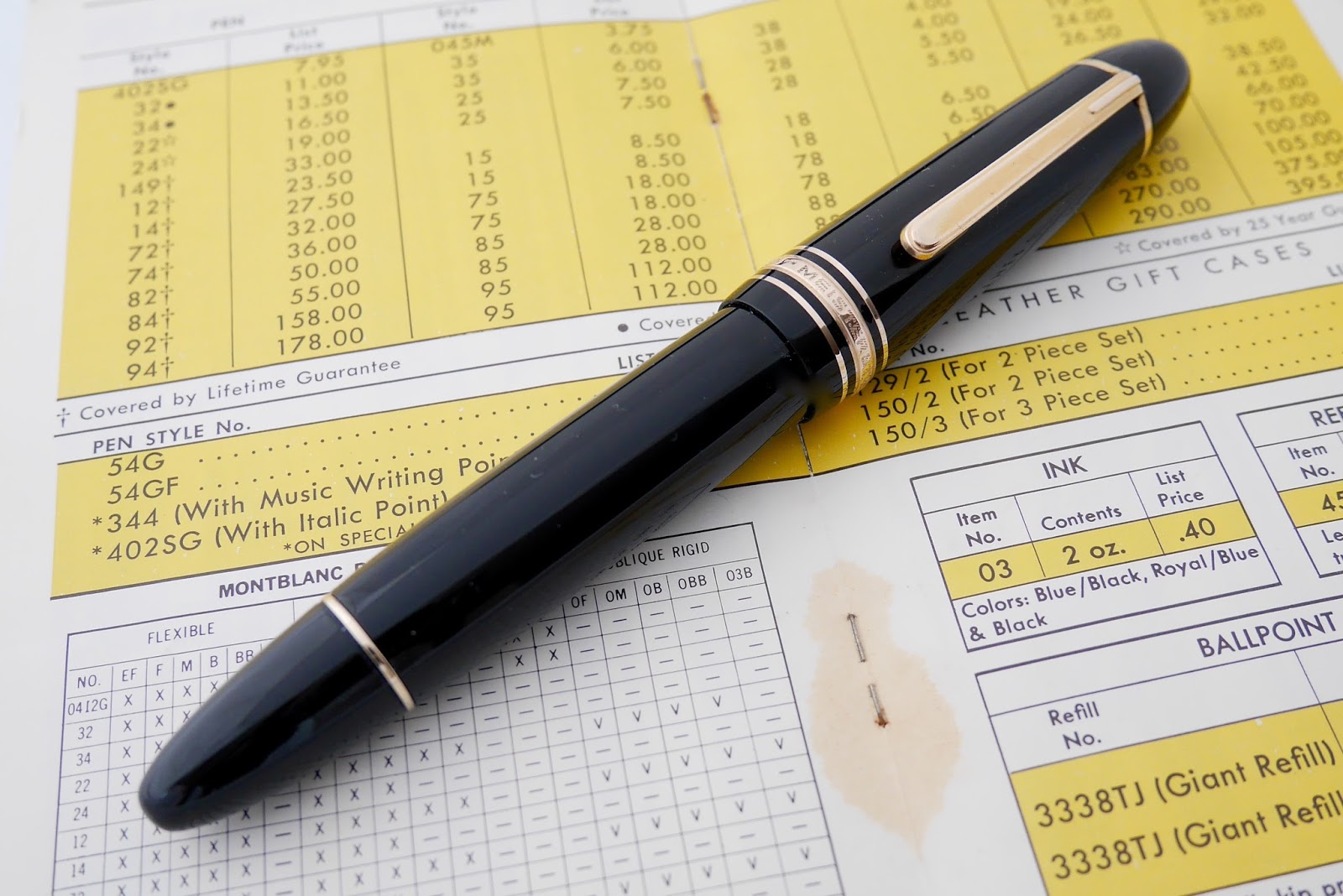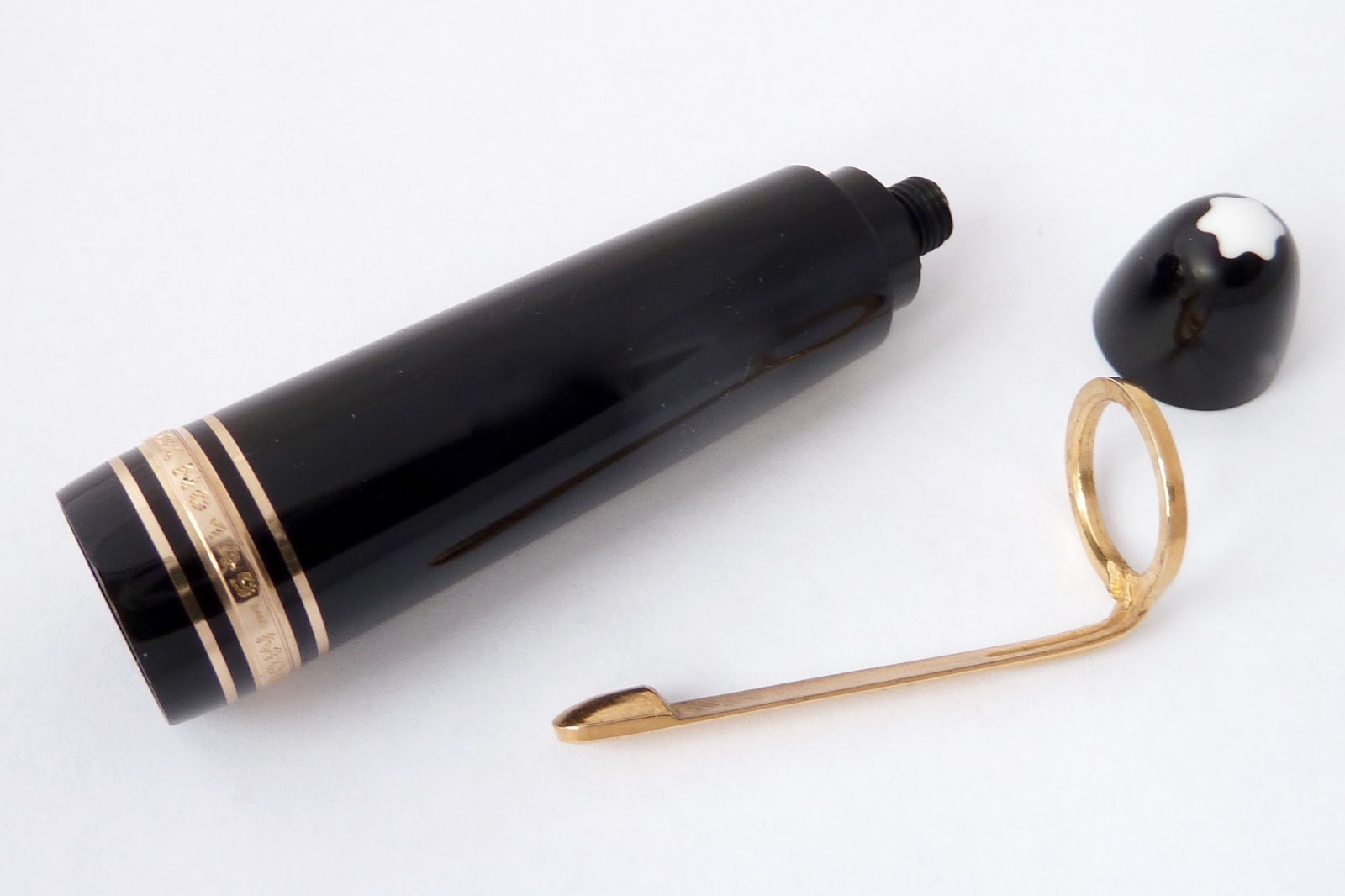Part II
In the early 1960s Montblanc's line of pens underwent significant changes including their flagship pen: the Meisterstück 149. While keeping its basic shape, most importantly the construction of the 149 was modified but also materials were replaced. The largest Meisterstück pen was no longer made from celluloid on a lathe but rather put together from parts made out of plastic. What later would be marketed as precious resin is not unlikely to be some sort of plexiglass or Polymethylmethacrylate (PMMA), also known as acrylic.
 |
| later 1950s celluloid pen and early 1960s resin pen (from top to bottom) |
 |
early 1960s and 1970s pen (from top to bottom) |
The original 1950s 149 pens used a two-piece construction for the barrel with a separate gripping section which screws onto the barrel. This was omitted and a single barrel construction made its appearance. Also one of the technically most advanced features of the previous Montblanc fountain pens - the multi-stage telescopic piston mechanism - was replaced by a more simple, single-stage piston mechanism made from all plastic parts.
Also this newly constructed piston-unit was friction-fit rather than being screwed in. The friction-fit piston unit also was used on other Montblanc pens of that period of time like the Meisterstück 12 and 14 but also on pens of the second and thirtier series. For the 149 it was used only for a few years before being replaced again with a screw-in unit at the beginning of the 1970s.


 |
| parts of the piston unit; please note the little golden barrel ring which is still curved like on the on the celluloid models and the white colored helix rod for the piston |
The material used for the barrel end of the early 1960s pen was thinner compared to later 149 pens using a screw-in piston unit. From today's point of view this is a weak point of the early resin pens. The friction-fit piston unit requires special caution when having to remove it for maintaenance. The thin material leads to cracked barrels quite commonly.
 |
| single piece barrel from a 1970s showing the internal threads for the piston unit and early 1960s pen for friction-fit piston units (left to right) |
The early 1960s 149 is a very light weight pen since the only metals parts are clip, nib, barrel and cap rings as well as a tiny c-ring holding in place the helical rod in the filler knob. Later models will have a brass made threading on the piston unit adding significant weight to the pen and shifting balance to the back of the barrel.
 |
| 1970s pen with screw-in piston unit and flat barrel ring in comparison to a 1960s friction-fit piston unit with rounded barrel ring (from top to bottom) |
 |
| 1970s and early 1960s pens (from top to bottom) |

 |
| for professional removal a special tool is used to pull out the piston unit; my thanks go to Horst-Max Schrage from Astoria Schreibkultur, Hamburg (www.astoriapen.hamburg& www.maxpens.de) for allowing me to show the original Montblanc tool |
While later 1970s models still were of similar construction minor changes were made to the design of the raised lip of the barrel's front opening as well as to the threaded area. Still caps are interchangeable between all single-piece barrel models from the 1960s and 1970s.
 |
| the heat stamped marking of the model number on the filler cone was omitted on the newer resin pens; 1950s celluloid pen, early 1960s pen with rounded barrel ring and 1970s pen with flat barrel ring (left to right) |

Either 14 C or 18 C tri-tone nibs were used in the 1960s with a design almost identical to earlier ones. Still most 1960s nibs show less flexibility to their predecessors. The nib-feed assembly also was similar to the ones installed in the celluloid pens. At least two new versions of feeds were used on those pens still using ebonite. Early pens have a round feed with two grooves which were left out later.
 |
| nib-feed assembly with early ebonite feed with two grooves underneath |
 |
| three generations of Montblanc 149 pens showing their feeds from underneath: later 1950s round feed with long grooves, early 1960s feed with two short grooves and later round version without grooves |
 |
| broad, medium oblique and extra fine nibs on a 1950s, 1960s and 1970s Meisterstück |

Among the most obvious changes was the replacement of the two silver cap-rings which were typical for the flagship models 129, 139 and 149 during the previous decades with gold plated rings. Also the famous trademark depicting the snow covered summit of the Mont Blanc mountain now shines and stays in bright white resin.
 |
| unfortunately most caps from early 1960s pens show hairline cracks in the cap lip today |
While the clip ring of 1950s Meisterstück pens show no inscriptions, the clips of the first resin caps were marked either "MADE IN GERMANY" or "GERMANY". A serial number was yet to come.
 |
| clip, cap band imprints and cap top underwent minor changes during the production period allowing to determine their place in time |
 |
| 1950s, 1960s and 1970s cap bands (bottom to top) |
In the early 1960s the 149 retailed for c. US $ 35. For comparison a Sterling Silver Parker 75 was sold for US $ 25. During this time, smaller and thinner fountain pens became en vogue along with a growing variety of ballpoint pens. Today a new 149 is sold for US $ 935 or 750 € (Dec. 2015).
The Diplomat Meisterstück 149 was one of the last few true oversize pens available in the 1960s. Even most Montblanc pens showed a more sleek and modern design like the 1x, 2x and 3x series. Until today the Meisterstück is recognized as a distinctive mark and holds a special place in the history of fountain pens.
Today the early resin 149 fountain pens are on the verge of being considered vintage pens but collectors or users still show more passion for the original celluloid version. They are still around, but finding one in original condition ist getting more difficult. Some pens have undergone repair or maintenance were parts have been replaced with more modern parts. This also is true for work which has been performed by Montblanc's service centers. A nice user grade 149 can always be found for a fair price with some patience and in some rare cases this might be an early resin model. Today's market prices are still lower compared to a a 1950s celluloid model but in excellent condition the early resin 149 might be sold for the price of a brand new one or even above.
Part III will follow to see what happened to the big Meisterstück in the 1970s. Check out part I here.

















